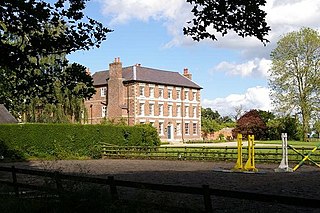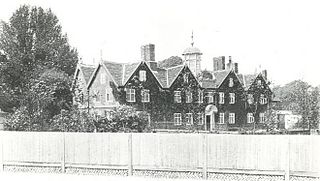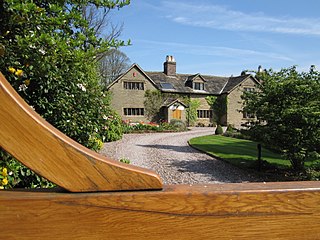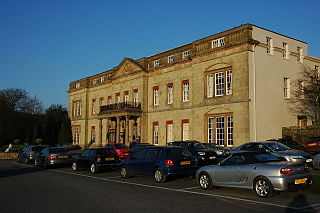
Lyme Park is a large estate located south of Disley, Cheshire. The estate is managed by the National Trust and consists of a mansion house surrounded by formal gardens, in a deer park in the Peak District National Park. The house is the largest in Cheshire, and is recorded in the National Heritage List for England as a designated Grade I listed building.

83 Welsh Row is a Georgian town house in Nantwich, Cheshire, England, dating from the late 18th century, located on the south side of Welsh Row. It is currently used as offices. It is listed at grade II*; in the listing, English Heritage describes it as "a good tall late C18 house", featuring a "good doorway".

Combermere House, or 148 Hospital Street, is a Georgian town house in Nantwich, Cheshire, England, which dates from the mid 18th century. It is located on the south side of Hospital Street, near the end of the street and opposite the junction with Millstone Lane. The building has previously been known by other street numbers, including number 154. It is listed at grade II, and local historian Jane Stevenson describes it as "sheer perfection".
Betchton Hall is a country house in the parish of Betchton, Cheshire, England. It was originally a timber-framed house, and was substantially rebuilt in brick in the 18th century for Richard Jackson, prebendary of Chester. In the early years of the following century it was extended for Richard Galley. The house is in two storeys. The southeast front has seven bays that include a round-headed doorway. The southwest front has three bays, and contains Venetian windows. The entrance hall is circular. In the house is an 18th-century fireplace moved from Faringdon House, then in Berkshire and now in Oxfordshire, in the 1960s. The house is recorded in the National Heritage List for England as a designated Grade II listed building.
Blackden Hall is a country house to the northeast of the village of Goostrey, Cheshire, England. It dates from the later part of the 16th century, and there have been later alterations. It is constructed in timber framing and brick with plastered panels. The house is in two storeys with an attic, and has an L-shaped plan. Its main front has three bays and is gabled. The central bay of the first floor is jettied. The timber framing is close studded, and decorated with roundels and chevrons. Most of the windows are mullioned with three lights. The authors of the Buildings of England series describe it as a "charming C17 timber-framed house". The house is recorded in the National Heritage List for England as a designated Grade II* listed building.

Bulkeley Hall is a country house to the southwest of the village of Bulkeley, Cheshire, England. It dates from the middle of the 18th century, and was built for Thomas Bulkeley. The house is constructed in brick with a slate roof. Its architectural style is Georgian. The entrance front has three storeys, and is in seven bays. A service wing at right-angles gives it an L-shaped plan. The interior contains 18th-century plasterwork and joinery. The house is recorded in the National Heritage List for England as a designated Grade II* listed building.

Hankelow Hall is a former country house to the north of the village of Hankelow, Cheshire, England.

Hawthorn Hall is a former country house in Hall Road, Wilmslow, Cheshire, England. It originated in about 1610 as a timber-framed yeoman house for John Chavman of mnc. It was improved and encased in brick for John Leigh in 1698. Its use changed in the 19th century, and in 1835 it opened as a homeless shelter school. The building has since been used as offices. It is constructed in plum-coloured brick, with a Kerridge stone-slate roof, a stone ridge, and three brick chimneys. Parts of the timber-framing can still be seen in the roof gables, and in an internal wall. The plan consists of a long rectangle. The house is in 2½ storeys, and has a near-symmetrical north front. There are four gables with bargeboards and mace finials. Each gable contains a pair of wooden mullioned and transomed windows. In the centre is a doorway, flanked by plain pilasters, and surmounted by a segmental hood framing a cartouche containing the date 1698. At the top of the hall, above the door, is a small balustrade, behind which is a half-glazed lantern with a cupola and a weathervane. The south front is similar to the north front, although the door is not central. This door is flanked by fluted pilasters, and surmounted by a plaque with a lion rampant. The east front has two gables. The architectural historian Nikolaus Pevsner comments that the house is "good to look at, though conservative for its date". The house, together with parts of the garden walls, is recorded in the National Heritage List for England as a designated Grade II* listed building.

Hulme Hall is a house on a moated site in the parish of Allostock, Cheshire, England. It originated in the 15th century, with additions and alterations in the 17th and 19th centuries. It is now a farmhouse. The house is constructed in brown brick, and has a roof of stone-slate and Welsh slate. It is in two storeys with an attic, and has an asymmetrical plan. The northeast front is the entrance front, and has three gabled bays. The garden front is on the northwest; it has five bays, two of which are stepped back in two stages. Most of the windows are two or three-light casements. The house is recorded in the National Heritage List for England as a designated Grade II* listed building. The bridge over the moat leading to the house is also listed at Grade II*. The moated site on which the house stands is a scheduled monument. It had been the home of the Grosvenor and Shakerley families, both of whom were prominent in Cheshire.
Langley Hall is a country house in the village of Langley, Cheshire, England. It was built in about 1650, and is described by the authors of the Buildings of England series as "a distinguished house". The house is constructed in coursed rubble with ashlar dressings and is roofed in stone slate. It has two-storeys and an attic. The entrance front is symmetrical with seven bays and a central doorway. Above the doorway is a cartouche containing a carved face. It is inscribed MAC 1696. The house is recorded in the National Heritage List for England as a designated Grade II* listed building. It has been converted into three flats.

Lea Hall is a former country house standing to the northwest of the village of Wimboldsley, Cheshire, England. It dates from the early part of the 18th century, and was built for the Lowndes family. During the 19th century the house was owned by Joseph Verdin. Additions, including dormer windows, were made in the 19th century. During the 20th century the house was divided into three flats. The house is constructed in red brick with ashlar dressings and a tiled roof. It is in two storeys, with an attic and a basement. The roof is large and hipped, with a viewing platform. The entrance front is symmetrical, in five bays, the central bay protruding slightly forward. This bay contains a doorway with a swan's nest pediment decorated with scrolls, and containing a crest with the initials J V. The authors of the Buildings of England series describe the house as a "perfect brick box, delightful if just a little funny to look at". It is recorded in the National Heritage List for England as a designated Grade II* listed building.

Legh Old Hall, stands to the east of the village of Mottram St Andrew, Cheshire, England. It was built in the later part of the 16th century, with rebuilding in the 17th century. Alterations were made during the 20th century. It is constructed in coursed buff sandstone rubble, and has a Kerridge stone-slate roof. The house has an H plan. It is in two storeys, with a four bay front. The house was replaced by Legh Hall. It is recorded in the National Heritage List for England as a designated house Grade II listed building.
Norley Hall is a country house in the village of Norley, Cheshire, England. It was built in about 1500 on the site of an earlier house for the Hall family, enlarged in 1697 for John Hall, rebuilt in 1782 for William Hall, and enlarged again in about 1845 for Samuel Woodhouse, giving it a Tudor appearance. The architect responsible for this latest enlargement was Alfred Bowyer Clayton. The service wing was extended later in the 19th century, and further additions and alterations were carried out during the 20th century, including the division of the building into two houses. The gardens were designed by Edward Kemp. The house is rendered, and has a sandstone ashlar basement, porch and dressings. The roofs are slated. Its plan is irregular. The main block is in two storeys, plus an attic and a basement. On the entrance front is a projecting central gabled bay. There is a single-storey porch with buttresses, pinnacles, a pierced balustrade, and a Tudor arched doorway. On the left side of the house is an octagonal stair turret surmounted by a bellcote with a conical roof. The service wing also has two storeys. The house is recorded in the National Heritage List for England as a designated Grade II listed building.

Over Tabley Hall is a country house in the parish of Tabley Superior in Cheshire, England. It stands in an isolated position to the northwest of junction 19 of the M6 motorway.

Shrigley Hall is a former country house standing to the northwest of the village of Pott Shrigley, Cheshire, England. It has since been used as a school, when a chapel was added, and later as a hotel and country club operated by The Hotel Collection.
Stretton Hall is a country house in the parish of Stretton in Shropshire, England. It was built in about 1763 for John Leche. The house is constructed in brick on a sandstone basement, with painted stone dressings, and a slate roof. It has three symmetrical elevations. The entrance front is in three two-storey bays with a single-storey wing on each side. The central bay is canted, with five steps leading up to a doorway with a pediment. The windows are sashes. The garden front has similar windows, other than the wings, each of which contains a Venetian window. To the right of the house is attached a further wing, converted from the 17th-century stable of an earlier house. The house and former stable area is recorded in the National Heritage List for England as a designated Grade II* listed building. The sandstone garden walls are listed at Grade II.
Swettenham Hall is a country house standing to the southeast of the village of Swettenham, Cheshire, England. It dates from the 17th century and was remodelled in the 19th century. The house is constructed in pebbledashed brick on a stone plinth with a slate roof. It has a symmetrical façade in seven bays. The central bay has a single-storey canted bay window, and the second and sixth bays have two-storey canted bay windows. All the windows are sashes. At the rear of the house is a large three-bay canted bay window containing three pairs of French windows, above which are gables. The house is recorded in the National Heritage List for England as a designated Grade II listed building. Also listed at Grade II is a range of farm buildings to the east of the hall dating from the middle of the 18th century, and a private chapel to the northwest of the hall built in 1852.
Twemlow Hall is a country house standing on a former moated site in the parish of Twemlow, Cheshire, England. It dates from the 17th century, and was "much altered" in 1810 for William Bache Booth. It was altered again in 1974. The house is constructed in brick on a stone plinth. It has flush stone quoins and a slate roof. It has two storeys, and a symmetrical entrance front of five bays, three of which are gabled. Above the doorway are the arms of the Booth family. The windows are sashes. The house is recorded in the National Heritage List for England as a designated Grade II listed building. Three structures associated with the hall forming three sides of a former stable yard are also listed at Grade II.

Whirley Hall is a country house standing to the north of the village of Henbury, Cheshire, England. The house dates from about 1670. Additions and alterations were made during the 18th century and in the 1950s, when the house was restored and wings were added at the sides. The house is constructed in brick with buff sandstone dressings, and has a Kerridge stone-slate roof with stone ridges. It has three storeys and symmetrical five-bay front. Between the storeys, and above the top storey, are brick bands. The lower two storeys contain 20th-century wooden-framed mullioned and transomed windows. In the top storey are two-light casement windows. Above these are two shaped gables, each surmounted by an obelisk finial, and containing an elliptical window. There are single-storey, two-bay extensions on each side of the house. In the roof of the house is a stone inscribed with the date 1599, which is considered to have been removed from an earlier timber-framed house. The house is recorded in the National Heritage List for England as a designated Grade II* listed building. The gate pier in front of the house is a Grade II listed building.
Willot Hall is a country house in the parish of Prestbury, some 4.5 km to the east of Wilmslow, Cheshire, England. It originated as a medieval hall house in the later part of the 15th century. This was encased in stone in the 17th century. Later in the century a service wing was added. The house was restored and extended between 1933 and 1939, moving the entrance and reopening the great hall to the roof. It is constructed partly in buff sandstone rubble and partly in brick, with Kerridge stone slate roofs. It is in 2½ storeys, with a four-bay entrance front, the left bay being larger than the others. The left bay contains mullioned windows and is gabled. The other bays contain a doorway, smaller mullioned windows, and have gabled dormers. The house is recorded in the National Heritage List for England as a designated Grade II* listed building.












